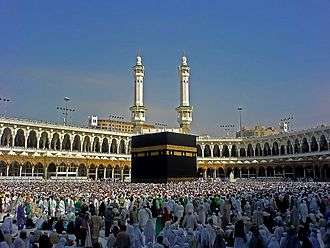Maghrib prayer
| Part of a series on |
| Islam |
|---|
 |
|
The Maghrib prayer (Arabic: صلاة المغرب ṣalāt al-maġrib, '"West prayer"), prayed just after sunset, is the fourth of five obligatory daily prayers (salat) performed by practicing Muslims.[1]
The formal daily prayers of Islam comprise different numbers of units, called rakat.[1]
The Maghrib prayer has three obligatory (fard) rak'at and two recommended sunnah and two non-obligatory nafls. The first two fard rak'ats are prayed aloud by the Imam in congregation (the person who misses the congregation and is offering prayer alone is not bound to speak the first two rak'ats aloud), and the third is prayed silently.[1]
To be considered valid salat, the formal daily prayers must each be performed within their own prescribed time period. People with a legitimate reason have a longer period during which their prayers will be valid.[2]
Name variations
| Region/country | Language | Main |
|---|---|---|
| Arab World | Arabic | صلاة المغرب (Ṣalāh al-Maghrib) |
| Afghanistan, Iran, Tajikistan | Persian | نماز مغرب |
| Afghanistan | Pashto | مګبیبی دعا |
| Pakistan, India | Urdu | نماز مغرب (Maghrib namaaz) |
| Turkey | Turkish | Akşam namazı |
| Azerbaijan | Azeri | Şam namazı |
| Albania, Kosovo | Albanian | Namazi i akshamit, Namaz i mbrëmjes |
| Balkans | Serbo-Croatian, Bosnian | Akšam-namaz |
| Bengal | Bengali | মাগরিব (Magrib, mugrib) |
| Greater Somalia | Somali | Salaada Magrib |
| Indonesia | Bahasa Indonesia, Basa Sunda | Salat magrib |
| Malaysia | Bahasa Melayu | Solat maghrib |
| Uzbekistan | Uzbek | Shom namozi |
| Iraqi Kurdistan | Sorani | نوێژی مەغریب |
Sunni tradition
Time begins
- When the sun has completely set beneath the horizon; immediately after the Asr prayer period ends.[1]
Time ends
- Most other scholarly opinions hold that the time for Maghrib prayer ends when the time for Isha'a salat begins. There is disagreement amongst Sunni scholars as to when that occurs. According to the Hanafi school, Isha'a begins when complete darkness has arrived and the yellow twilight in the sky has disappeared.
- According to a minority opinion in the Maliki school, the prescribed time for Maghrib prayer ends when the red thread has disappeared from the sky. In another opinion of the Shafi'i school, the disappearance of the red thread marks the end of the Period of Necessity. These times can be approximated by using the sun as a measure. When the sun has descended 12 degrees below the horizon, it is approximately equivalent to the disappearance of the red from the sky. For approximating when complete darkness begins, i.e. the disappearance of the white thread from the sky, some astronomers argue that it occurs when the sun has descended 15 degrees below the horizon while others use the safer number of 18 degrees.[3] [4]
 Maghrib prayer in Udaipur, Mughal Empire.
Maghrib prayer in Udaipur, Mughal Empire.
Shia tradition
The redness of the eastern sky - that persists in the east for some time after sunset - disappears from the eastern half of the sky, and thus from above one's head when one looks vertically upwards in the sky.[1]
Time ends
- At midnight. The end of its time is after approximately eleven-and-a-quarter hours have passed from the legal noontime. This is for when one is under normal circumstances. However, in the case of one who was asleep, or forgot to perform the prayer or was coerced by extraordinary circumstances or factors beyond his control or in the case of woman whose prayer was delayed due to menstruation, the end of the Maghrib prayer time is Fajr.
Despite the relatively long period in which valid prayers can be recited, it is considered important to recite the prayer as soon as the time begins.
Shia doctrine permits the mid-day and afternoon and evening and night prayers to be prayed in succession, i.e. Zuhr can be followed by Asr once the mid-day prayer has been recited and sufficient time has passed, and Maghrib can be followed by Isha'a once the evening prayer has been recited and sufficient time has passed.
See also
References
- 1 2 3 4 5 A guide to Maghrib prayer, qul.org website, Retrieved 14 May 2017
- ↑ Significance of Offering the Isha and Maghrib Prayers and their Benefits, QuranReading website, Published 29 January 2015, Retrieved 14 May 2017
- ↑ Ibn Rushd. Bidayat al-Mujtahid wa an-niyahata al Muqtasid. ISBN 1873938136.
- ↑ Chart of Prayer Times for anywhere in the world available on IslamicFinder website, Retrieved 14 May 2017
